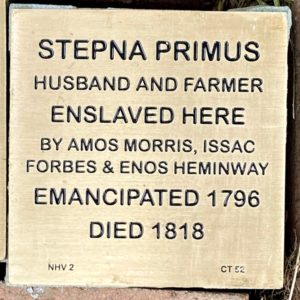From Witness Stones Unearth New Haven’s History Of Enslavement
Cold Spring students Nala Annes and Ava V. noted that one of the cruelties of enslavement is how much it erases from the historical record. They are more certain that consumption ultimately killed Stepna in 1818, for instance, than they are of his early life and the work he was forced to do while enslaved at the house. Charting the history of the Triangle Trade, they estimated that he was stolen from West Africa and brought against his will to Connecticut in the second half of the eighteenth century, possibly the 1770s.
Based on the life and story of Venture Smith, they said that Stepna was likely made to farm or mine salt for Amos Morris, a salt merchant who had a business mining salt out of the Long Island Sound until his supplies were demolished during the Revolutionary War. Morris’ operation relied on filling huge vats with seawater that would then evaporate, and the two guessed that one of Stepna’s tasks may have been lifting huge, heavy pots of seawater. In their research, the two found evidence that Stepna was “rented out,” as if his body were a piece of property.
There are a few things that remain certain: he and Pink were able to marry each other in a church in May 1791, meaning that there is a record of their union. Together, they had one known child named Chloe. After Hemmingway emancipated him in 1796—perhaps propelled by the Manumissions Act of 1792—he bought land that Pink later owned. He was 50 years old when he died of consumption, leaving his wife and child.



